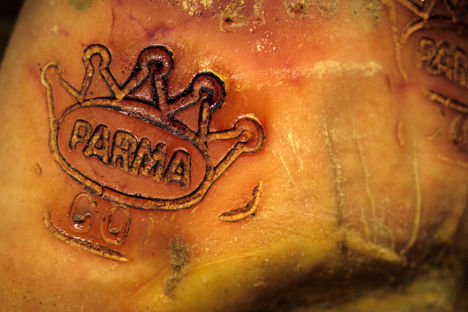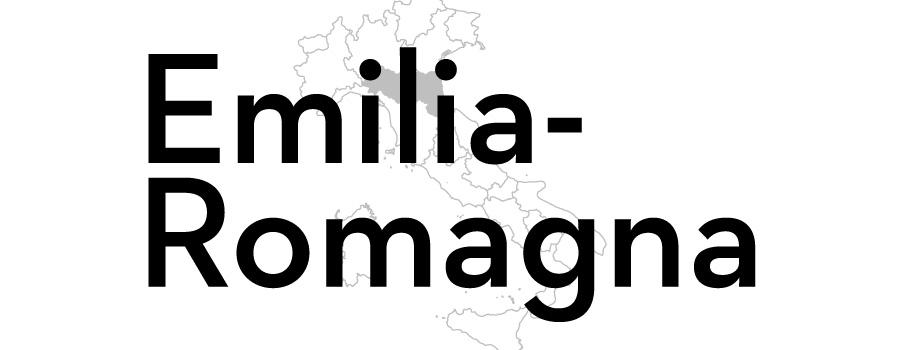
Parma's crowning glory - Prosciutto di Parma from start to finish
Ella Timney visits renowned Parma ham producer Pio Tosini to see how this iconic prosciutto is made, from the first salting to the final firebranding.
Parma's crowning glory - Prosciutto di Parma from start to finish
Ella Timney visits renowned Parma ham producer Pio Tosini to see how this iconic prosciutto is made, from the first salting to the final firebranding.
On scanning through photos of Parma on Google Images, as anyone faced with a trip there would, I was struck by something strange. Alongside the glorious opera house and endless butter-coloured buildings were dotted photographs of what can only be described as ham caves – thousands upon thousands of legs lining walls and ceilings, hanging in wait at the end of a long, hard cure, lit from above like some kind of hammy Christmas grotto. Where were these places? How could I get there?
A month later, I found myself on a minibus in Italy with a number of other ham-enthused journalists for the Prosciutto di Parma festival – yes, a festival of ham – on a journey to Pio Tosini, a company that has been producing Parma ham since 1905. After several days in Parma learning about how ham (and cheese) and culture are intertwined with the city’s history, from the sculptures in the baptistery depicting the winter pig slaughter to the great Parma ham legs and Parmesan wheels that adorned every deli and restaurant, it was now time to get geeky and see how this sweetly nutty, melt-in-the-mouth ham was made.
Driving up into the hills of Langhirano was a sweet relief, with gentle breezes proving a tonic to the intense mugginess of Parma itself, which sits in the river Po valley and as such collates warm, damp air. As we would learn from our guide Giovanni Bianchi (the grandson of founder Ferrante Tosini) this dry, continual breeze that rolls down from the Apennine mountains is what makes this area so perfect for the production of Parma ham, said to have been made in this region since Roman times.
We arrived into the ‘fresh area’ of the factory, where huge hind legs arrive from local pigs. Before starting the curing process each leg is first assessed for just the right quantity of buttery white fat and beautiful skin, and branded with markers – each Parma ham winds up being as marked as a tattooed Russian gangster – denoting the origins of the pigs, age of pig at slaughter and the Pio Tosini brand of ownership. These marks, covering the legs in all kinds of mysterious numbers and cyphers that only the privy can identify, make each leg of Parma ham entirely traceable from beginning to end.
As we passed through lines of stainless steel machinery Giovanni talked us through the impact of food safety on a centuries-old process. Huge machines now take care of washing the salt from the hams after curing and massaging the legs after the first salting to remove any blood still sitting in the veins. But perhaps the most important process, the salting, is still carried out by hand by a Maestro Salatore, a ‘master salter’ who applies just the right amount depending on fat distribution and size, rather than completely submerging the legs in salt as is the case for many other hams. This approach is what gives Parma ham that perfectly just-cured finish that makes it so unique, and as salt is the only other ingredient used to make Parma ham, the process is of vital importance. No nasties, no nitrites, just pure sea salt. Balancing old and new, Pio Tosini save the elements that keep the ham artisanal, such as hand-salting, branding, and testing the hams at the final stages or curing, while adapting to the rigours of food safety enshrined in European law. And they have to; Pio Tosini alone produce approximately 100,000 hams per year for a global market, and companies within the Consortium of Parma ham (comprised of 150 producers) produce a whopping 11 million in total.
Giovanni pulled open the heavy door of a refrigeration unit to unveil our first glimpse of the hams, still in their infancy in this process which takes anything from 12–24 months to complete. Laid on racks after an initial salting, the legs still looked fairly pink and plump. Moving onto the next fridge the difference was palpable – after eighteen days the legs were much flatter, darker beasts thanks to the loss of moisture. The salt sparkled on the fat, working its magic and forcing the moisture out of the ham leaving small puddles of humidity on the floor.
The relatively modern practice of refrigeration in making Parma ham reflects a centuries-old seasonal rhythm. All in all the legs are in the cold area for 110 days, a practice harking back to pre-industrialised preserving practices. Originally, pigs were slaughtered in the winter in Langhirano in anticipation of the three months of cold and snow that lay ahead. Modern breeding practices mean that production can carry on year-round if needed, but Pio Tosini believe that killing pigs in spring leads to an inferior product, again echoing the seasonal fluxes of the past.
We then moved to the final cold stage, the legs looking dark and brooding hanging on their vast steel racks, where the bones are trimmed to accommodate for shrinkage. When the legs are brought out of the cold they are hung again to begin their drying period after blowing off the salt and rinsing away any excess that remains on the surface. The legs then begin the long, hard hang where the air tumbling off the mountains starts to work its magic as they are moved to warmer parts of the building. Before the final hang, they are smothered in a blend of salt and pork fat as a cosy protective layer, and then it’s just a matter of time and patience.
You would ordinarily think that this is where the story ends. What could possibly be next? Giovanni led us down to the cellars with a slight glint in his eye. This is where things get surreal. Walking into the cellar was like walking into a kind of dizzyingly geometrical Francis Bacon painting, with legs lining endless racks off into the distance, perfectly lined up to create a kaleidoscope of Parma ham.
After wandering around the cellar, mouths agape at the scale of the operation (there were 35,000 legs in there at the time), we were shown the Parma brand – the five-point Ducal Crown that gets heartily stamped onto each leg to show it is indeed prosciutto di Parma, and falls under the strict rules and regulations outlined by the Consortium.
Before the ham gets stamped, though, a delightful chap in a white coat and Parma ham cap holding aloft a slightly sinister-looking horse bone needle sidled up to a wall of hams and started expertly needling them. This lone ranger is responsible for inserting the needle (chosen for its porous properties) five times into each leg and quietly inspects the aromas to make sure the ham is perfect all the way through. Only after the needling has occurred does he take the brand (surely the coolest job in the office, no?) and press it onto each leg twice, leaving charred angry outlines of the Ducal Crowns on the skin – the final mark of this incredible process.
It’s all okay though, the ham is fine. It soon settles down and is left a little longer, leaving a hammy, dusty coating all over from the strange microclimate of the cellars. From here, the legs are either sold whole, or deboned by hand and packaged neatly into more manageable sizes – if by manageable, you mean 3kg of solid Parma ham leg. The rules for serving are as strict as the production: slice as thinly as is humanly possible. Wafer-thin, sweet, just-cured, this incredible process results in that addictively sweet, buttery ham that is so prolific in the UK. Do not forget this as you shove some into a baguette or gobble it off a cold cuts plate – it’s been through a lot, so pay it the respect it’s due.



